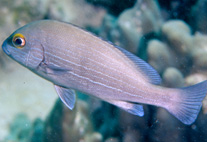Abstract
Two distinct haemulid fishes from Australia and the Indo-Australian Archipelago respectively have long been confused with Plectorhinchus schotaf (Forsskål, 1775). Plectorhinchus caeruleonothus sp. nov. is described from 17 specimens collected off western and far northern Australia, between the Monte Bello Islands, Western Australia and Torres Strait, Queensland. It has also been confirmed outside this range by photographs taken at Ningaloo Reef and Exmouth Gulf, Western Australia, and at Claremont Isles and Lizard Island, Queensland. The new species is unique among the genus in having a combination of dorsal-fin rays XII, 18–20, lateral-line scales 56–61, gill rakers 7–9 on the upper limb and 18–20 on the lower limb of the first arch, nostrils minute, and fresh colouration in adults including body uniformly grey, cheek, opercles and posterior margin of the opercular membrane uniformly blue-grey, and rim of orbit and upper edge of maxilla dusky yellow. In contrast to its closest congeners, the juveniles have a distinctive pattern of narrow creamish-white to pale grey stripes on a dark grey to chocolate brown background on the head and body, and oblique dark stripes progressing with growth to spots on the caudal fin. Plectorhinchus unicolor (Macleay, 1883) from Japan to northern Australia is resurrected from the synonomy of P. schotaf and redescribed on the basis of the holotype and 24 non-type specimens. Plectorhinchus unicolor is most similar to P. schotaf, but can be distinguished by fresh colouration, modal dorsal and pectoral-fin ray counts and DNA barcoding. Plectorhinchus schotaf appears to be restricted to the region from southeast Africa to the Arabian Sea, including the Red Sea and Persian Gulf. Plectorhinchus griseus (Cuvier in Cuvier & Valenciennes, 1830) from Indian and Sri Lankan Seas has previously been treated as a junior synonym of P. schotaf, but in accordance with Smith (1962), is here confirmed as a valid species, readily distinguished from the latter by a concavity in the lateral profile of the snout in adults, deep body and high soft dorsal-fin ray count. Comparison of the CO1 genetic marker utilised in DNA barcoding also resulted in significant genetic divergences between the new species, P. unicolor and their closest sampled congeners. Some behavioural observations are also presented for the species treated, including aggressive interactions between individuals of the new species, the likes of which have not previously been recorded among species of Plectorhinchus.

